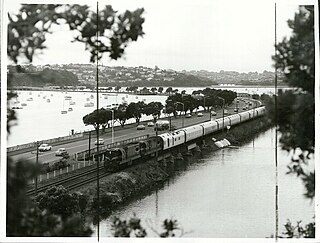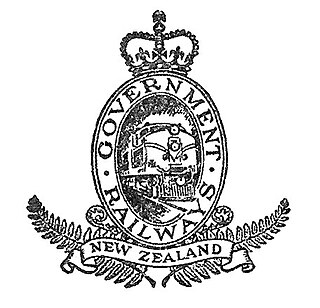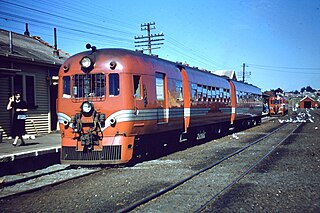Related Research Articles

The Kowloon-Canton Railway Corporation is a Hong Kong wholly government-owned railway and land asset manager. It was established in 1982 under the Kowloon-Canton Railway Corporation Ordinance for the purposes of operating the Kowloon–Canton Railway (KCR), and to construct and operate other new railways. On 2 December 2007, the MTR Corporation Limited (MTRCL), another railway operator in Hong Kong, took over the operations of the KCR network under a 50-year service concession agreement, which can be extended. Under the service concession, KCRC retains ownership of the KCR network with the MTRCL making annual payments to KCRC for the right to operate the network. The KCRC's activities are governed by the KCRC Ordinance as amended in 2007 by the Rail Merger Ordinance to enable the service concession agreement to be entered into with the MTR Corporation Limited.

Rail transport in New Zealand is an integral part of New Zealand's transport network, with a nationwide network of 4,375.5 km (2,718.8 mi) of track linking most major cities in the North and South Islands, connected by inter-island rail and road ferries. Rail transport in New Zealand has a particular focus on bulk freight exports and imports, with 19 million net tonnes moved by rail annually, accounting for more than half of rail revenue.
The Donnellys Crossing Section, also known as the Kaihu Valley Railway or Kaihu Branch, was a railway line in Northland, New Zealand. Initially an isolated line of 35.91 kilometres (22.31 mi), it became a branch line when the Dargaville Branch was opened and connected it with the North Auckland Line and the rest of the national rail network in 1943. The branch was closed in 1959.

The Silver Star was a luxury passenger train that ran overnight between Auckland and Wellington on the North Island Main Trunk (NIMT) railway of New Zealand, operated by New Zealand Railways (NZR). The train ran from Monday 6 September 1971 until Sunday 8 June 1979. It replaced the Night Limited express passenger trains which provided a faster service than the ordinary express trains, by stopping at only six intermediate stations en route and not hauling a postal (sorting) van as on previous trains.

Straits Air Freight Express (SAFE) was a cargo airline, established in 1950, named for its Cook Strait focus and connecting the North Island and South Islands of New Zealand's railway systems from the 1950s to the 1970s. The company was renamed Safe Air Limited in 1966 and diversified into aviation maintenance. In 1972 it was bought by the National Airways Corporation, which then merged with Air New Zealand. Safe Air continued to be operated as an independent entity by both owners. It ceased flying in 1990, but has continued to expand as a maintenance facility and now employs approximately 350 staff. In 2015 it was bought by the Australian arm of Airbus.

Interislander is a road and rail ferry service across New Zealand's Cook Strait, between Wellington in the North Island and Picton in the South Island. It is owned and operated by state-owned rail operator KiwiRail. Three roll-on roll-off (RORO) vessels operate the 50-nautical-mile route, taking about three hours to complete the crossing.

The New Zealand Railways Department, NZR or NZGR and often known as the "Railways", was a government department charged with owning and maintaining New Zealand's railway infrastructure and operating the railway system. The Department was created in 1880 and was corporatised on 1 April 1982 into the New Zealand Railways Corporation. Originally, railway construction and operation took place under the auspices of the former provincial governments and some private railways, before all of the provincial operations came under the central Public Works Department. The role of operating the rail network was subsequently separated from that of the network's construction. From 1895 to 1993 there was a responsible Minister, the Minister of Railways. He was often also the Minister of Public Works.

The NZR RM class 88-seaters were a class of railcar used in New Zealand. New Zealand Government Railways (NZR) classified them as RM (Rail Motor), the notation used for all railcars, numbering the 35 sets from RM100 to RM134. They were the most numerous railcars in NZR service. Their purchase and introduction saw the demise of steam-hauled provincial passenger trains and mixed trains, and was part of a deliberate effort to modernise NZR passenger services at a time of increasing competition from private motor vehicles. Being diesel powered and lighter the railcars were less expensive to operate and able to maintain quicker timetables, although became plagued with mechanical and electrical problems, with a number of the class eventually being turned into depowered locomotive-hauled carriages and reclassified as the AC class "Grassgrubs".

The NZR JA class was a class of fifty-one 4-8-2 steam locomotives operated by the New Zealand Railways Department (NZR). The locomotives were built in two batches; the first batch was constructed in-home at the Hillside Workshops at Dunedin between 1946 and 1956, while the second batch was produced by the North British Locomotive Company (NBL) of Glasgow, Scotland in 1951. To differentiate between the two batches, the locomotives were identified by their builder.

The New Zealand Midland Railway Company partially constructed the Midland line between Christchurch and Greymouth and the Nelson railway in the South Island. It was one of the few private railway companies in New Zealand, and it did not match the success of the Wellington and Manawatu Railway Company.

The Minister of Railways was the minister in the government responsible for the New Zealand Railways Department 1895–1981, the New Zealand Railways Corporation 1981–1993, and New Zealand Rail Limited 1990–1993. The portfolio was established in 1895, 15 years after the Railways Department was formed, and was abolished in 1993, when New Zealand Rail Limited was privatised. Today, KiwiRail is answerable to both the Minister of State Owned Enterprises, and the Minister of Transport.

The NZR RM class Sentinel-Cammell was a steam-powered railcar operated by the New Zealand Railways Department (NZR). It was the only one of its type to operate in New Zealand, and one of only two steam railcars trialled in the country; the other was the Clayton steam railcar.
Alfred Luther Beattie, typically referred to as A. L. Beattie, was a pioneering locomotive engineer. Born in Yorkshire, England, he gained fame as the Chief Mechanical Engineer of the New Zealand Railways Department (NZR) between 1900 and 1913. During this time, Beattie designed the Q class, the first 4-6-2 (Pacific) steam locomotive class in the world, and he was also one of the earliest people to use other wheel arrangements.

Sir John Alexander Armitt is an English civil engineer, and current chairman of the UK's National Infrastructure Commission.

New Zealand Railways Corporation (NZRC) is the state-owned enterprise that owns the land beneath KiwiRail's railway network on behalf of the Crown. The Corporation has existed under a number of guises since 1982, when the old New Zealand Railways Department was corporatised followed by deregulation of the land transport sector. In 1986, the Corporation became a State-owned enterprise, required to make a profit. Huge job losses and cutbacks ensued, and the rail network, rail operations and ferry service of the Corporation were transferred to New Zealand Rail Limited in 1990. The Corporation retained ownership of the land beneath the railway network, and charged a nominal rental to New Zealand Rail, which was privatised in 1993, and renamed Tranz Rail in 1995. In 2004, following a deal with Tranz Rail's new owners Toll NZ, the Corporation took over responsibility for maintaining and upgrading the rail network once more, trading under the name ONTRACK. Negotiations with Toll over track access charges concluded after four years with no agreement reached, so the government purchased the entire rail and ferry operations, naming the service KiwiRail. ONTRACK's railway infrastructure and employees were then transferred to KiwiRail in 2008, which itself was initially a subsidiary of the Corporation. On 31 December 2012, the Corporation once again became the landowner.

Ronald Leslie Bailey was a New Zealand politician of the Labour Party.
Chris Green is a British railway manager. He has a reputation for the adoption of business-led management of passenger services both in the British Rail and privatised eras, and has been described as "the best chairman BR never had".

George Peter Shirtcliffe is a New Zealand businessman. He was the chairman of Telecom New Zealand, New Zealand's largest listed company, from 1990 to 1999.
The Nelson–Blenheim notional railway (1957–1979) was part of the political management of the backlash from the New Zealand Railways Department's closure of the isolated Nelson Section, which ended hopes for a southern connection of Nelson to the rest of the South Island railway network.

Ashwani Lohani is a retired officer of Indian Railway Service of Mechanical Engineers. He has earlier worked as the Chairman & Managing Director of Air India and the former Chairman of the Railway Board of Indian Railways. After being retired from Government service on 23 July 2020 he joined GMR Group where He is currently serving as chief executive officer.
References
Citations
- ↑ Leitch & Stott 1988, p. 171.
- 1 2 "From the Executive Chairman". Rail Express: 2. July–August 1990.
- ↑ "From the Managing Director". Rail Express: 2. September–October 1990.
Bibliography
- Leitch, David; Stott, Bob (1988). New Zealand Railways: The First 125 years. Auckland: Heinemann Reed. p. 171. ISBN 0-7900-0000-8.